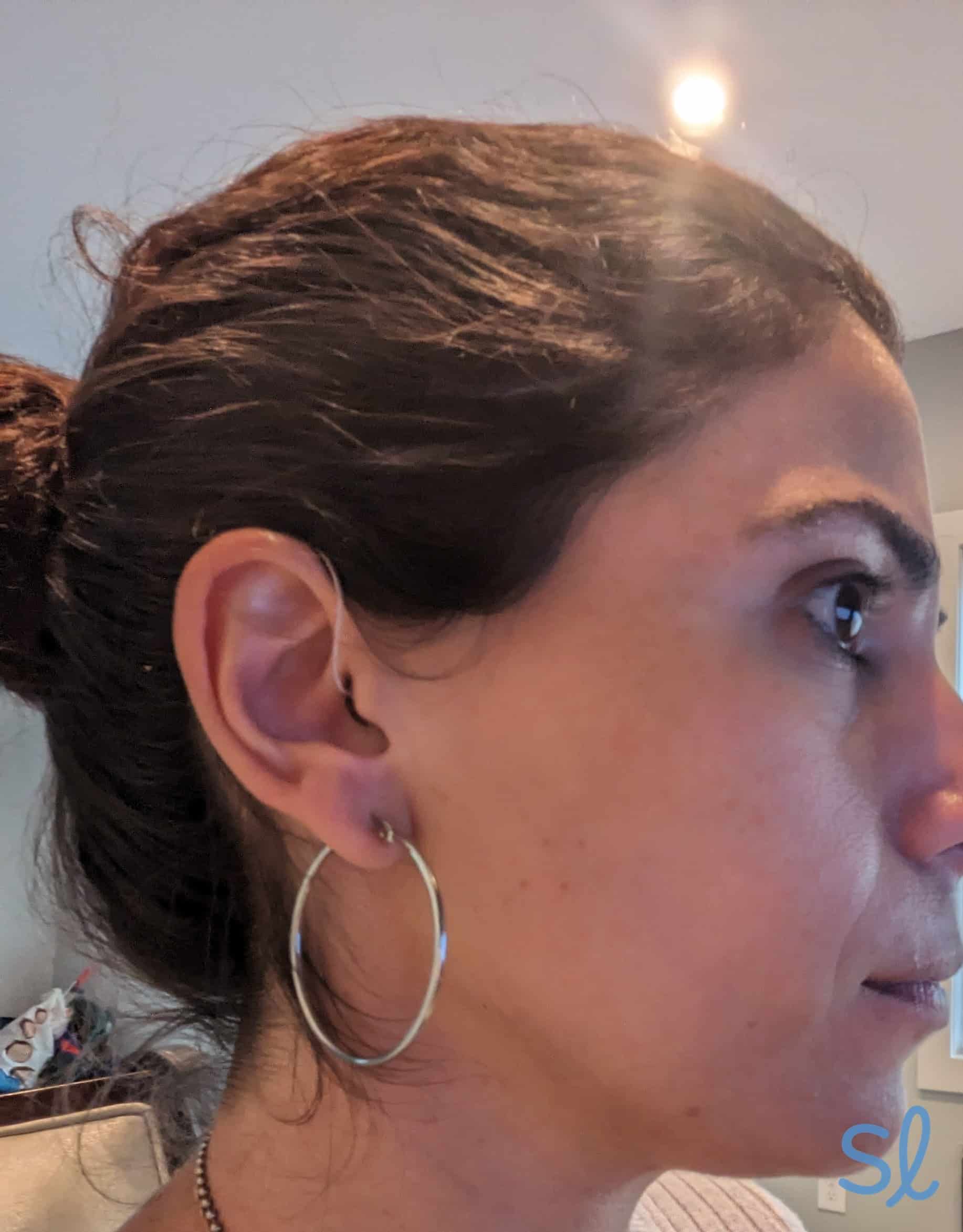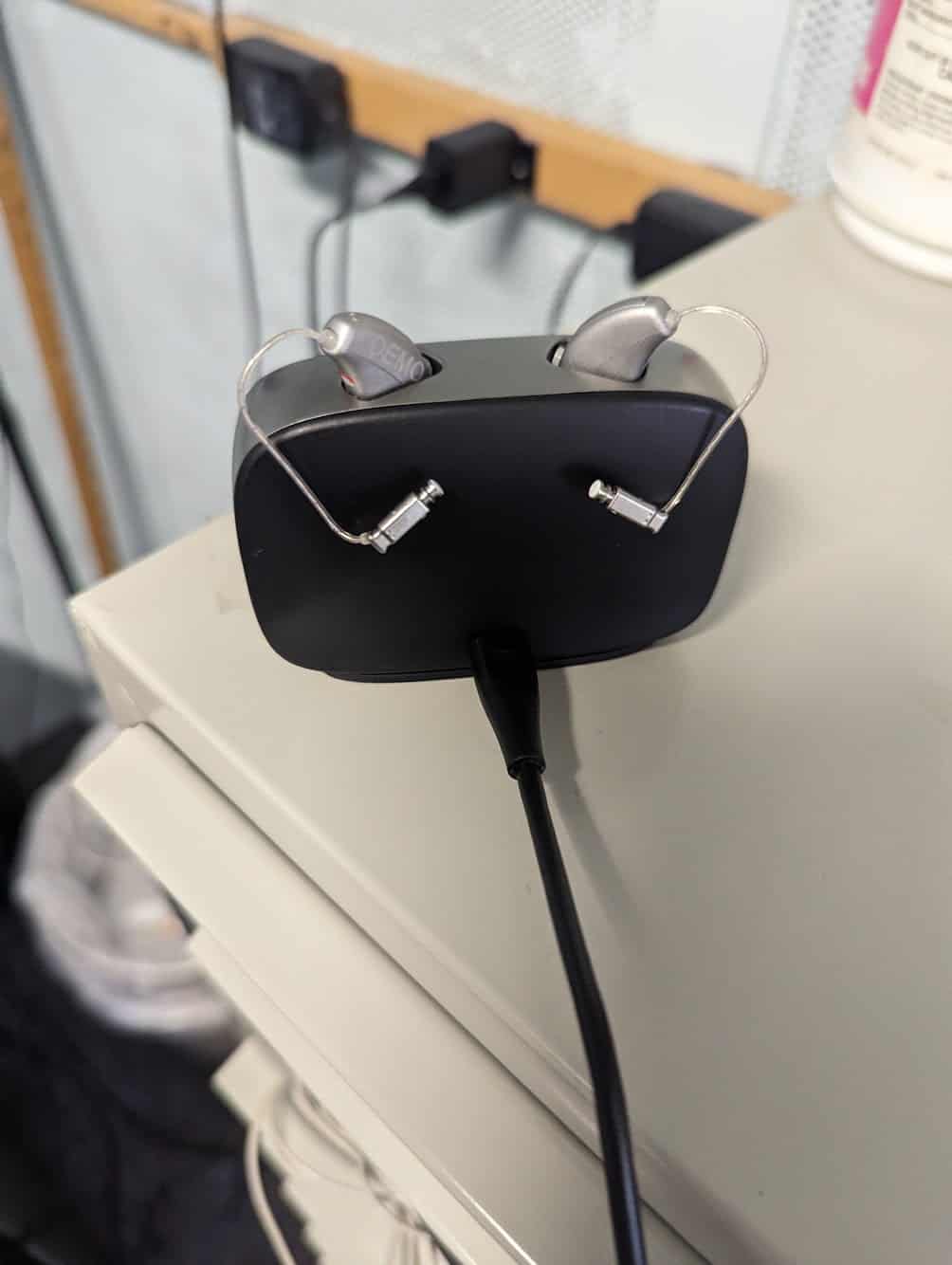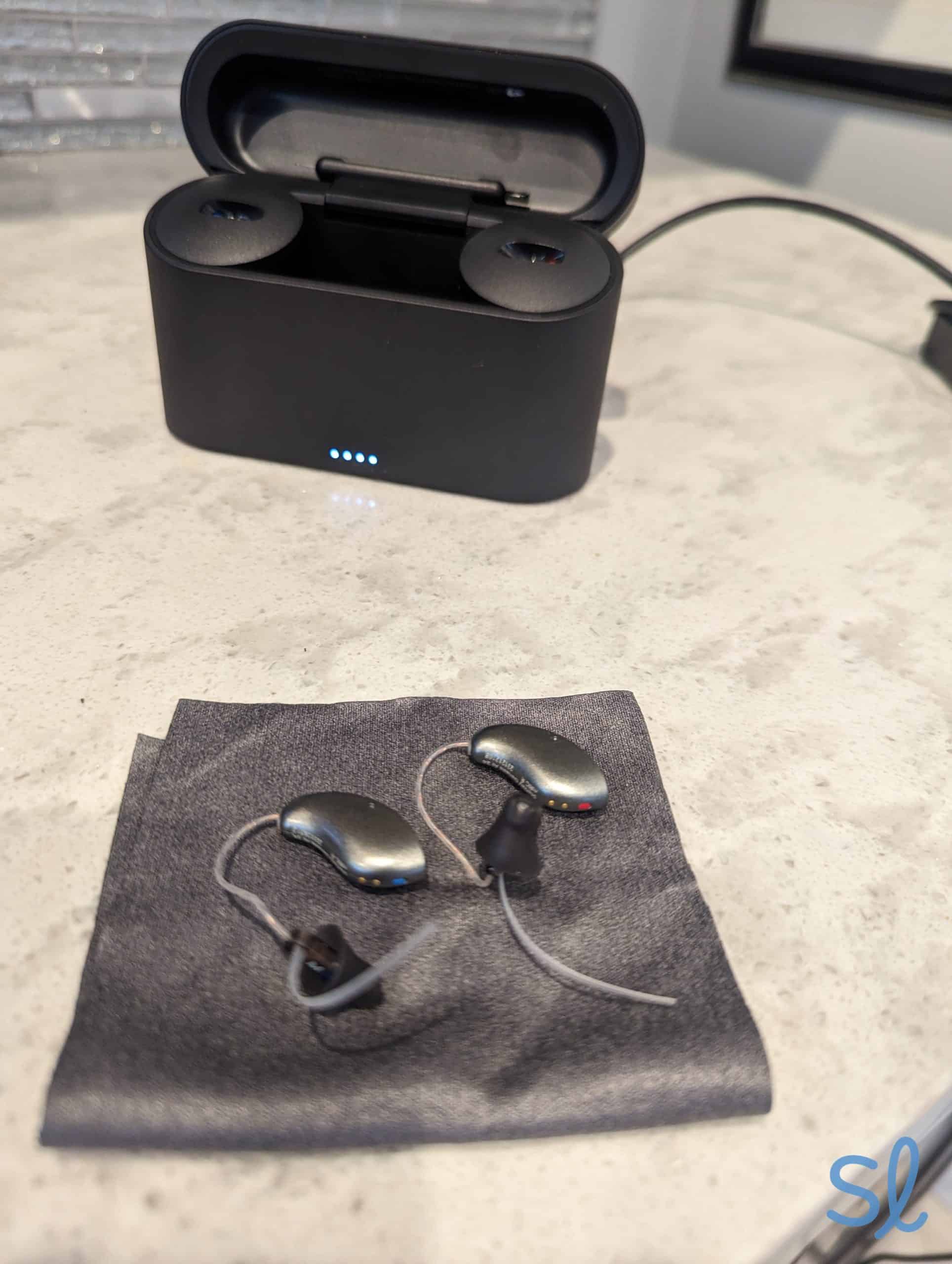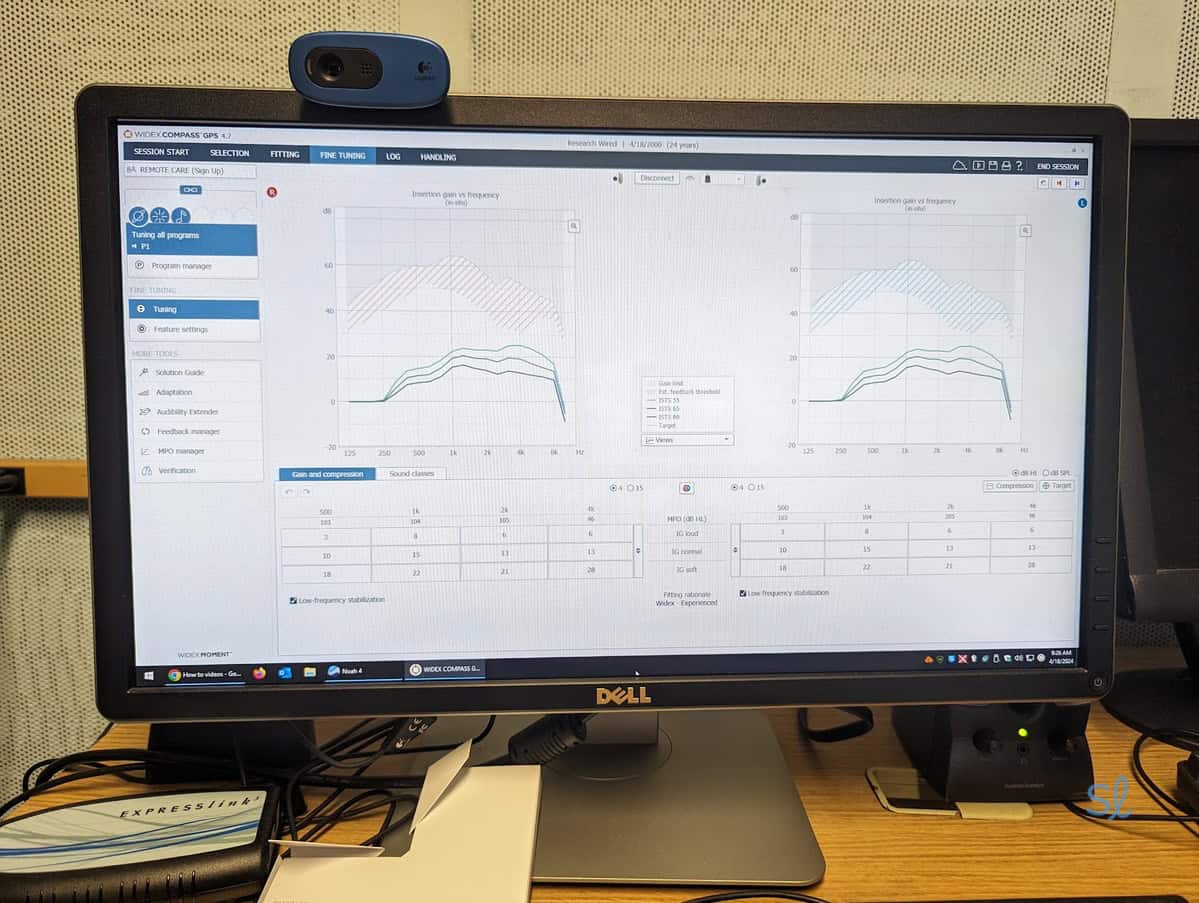Widex vs. Starkey
Widex is our top pick for musicians with hearing loss, while Starkey offers some of our favorite mobile app features.
SeniorLiving.org is supported by commissions from providers listed on our site. Read our Editorial Guidelines
Widex and Starkey are two major hearing aid companies that offer a wide variety of hearing aids for mild to profound hearing loss. Widex is a go-to solution for musicians with hearing loss, while Starkey offers some of the top mobile apps and features out there. Read on to learn about our first-hand experience with both providers, including insights from our resident audiologist, Dr. Ruth Reisman, as well as the differences between the providers, how each company’s products compare, and which brand has the best hearing aids for you.

Dr. Ruth Reisman wearing Starkey Genesis hearing aids

Widex
- Hearing aids for mild to profound hearing loss
- Rapid charging with fuel cell technology
- Zen technology and smartphone app for tinnitus relief
Starkey
- Hearing aids for mild to profound hearing loss
- On-the-go charging with battery life up to 51 hours (with select models)
- Wellness and brain activities via the Thrive app
Widex vs. Starkey Hearing Aid Types and Features

|

|
|
|---|---|---|
| Level of hearing loss | Mild to profound | Mild to profound |
| Bluetooth Capability | Yes | Yes |
| One-sided hearing loss | CROS available | CROS available |
| Tinnitus solutions | Yes | Yes |
| Styles offered | BTE, RIC, ITE, CIC | BTE, RIC, ITE, ITC, CIC, IIC |
| App | 4 apps | 5 apps |
| Accessories offered | COM-DEX streaming tool and remote mic, SoundAssist telecoil connector and mic, TV Play connector | Surflink media streamers, in-ear audio monitors for musicians, TV streamer, table mic, remote mics |
| Hearing aids for Veterans | Yes, through the VA | Yes, through the VA |
| Battery types | Rechargeable and disposable options | Rechargeable and disposable options |
| Website |
See Pricing
Links to Zip Hearing
|
See Pricing
Links to Zip Hearing
|
Widex and Starkey both offer technologically advanced devices for mild to profound hearing loss in a wide range of styles. To purchase hearing aids from either company, you’ll need to see a professional hearing specialist, such as an audiologist, in person. The audiologist will work with you to determine the cause and type of hearing loss you have. They’ll also discuss the types of hearing aids that may work best for you.
» Learn About: How To Choose A Hearing Aid
Widex Hearing Aids at a Glance
Overview
- Hearing aids for mild to profound hearing loss
- Excellent options for musicians
- Known for cutting-edge technology and innovative design
- PureSound technology produces undistorted, natural sound
- CROS hearing aids for one-sided hearing loss
- Tinnitus solutions
- SoundSense technology and Fluid Sound Analyzer use artificial intelligence (AI)
» Learn More: Best Hearing Aids for Single-Sided Hearing Loss
Widex Hearing Aid Models and Features
Widex manufactures a wide range of hearing aid styles, including one CROS (one-sided hearing loss) model. There are rechargeable and disposable battery options available throughout the brand’s offerings. Widex is known for cutting-edge hearing aid designs and using a state-of-the-art approach to producing natural sound quality. Below is a closer look at some of their current models.
Widex Moment Hearing Aids
Moment hearing aids use PureSound technology to process sound as quickly as possible, which cuts down on delays and the annoying feedback or tinny sounds that may occur with cheaper or less advanced hearing aids. The Moment and Moment Sheer lines also offer rechargeable models with batteries that can last for a full day or more on a single charge. That’s ideal for active seniors who may not always be near an outlet.

» Related Reading: Best Hearing Aids for Active Lifestyles
The standard Moment line offers behind-the-ear (BTE), receiver-in-canal (RIC) and in-the-ear (ITE) models. The Moment Sheer is a specialized BTE model with a sleek, modern design; Bluetooth connectivity; and up to 29 hours of battery life on a single charge. It’s a solid choice for older adults who want a slightly more discreet option that still has all the power and advanced tech you would expect from a high-end BTE hearing aid.

Testing out Widex Moment hearing aids
Widex Evoke Hearing Aids
Evoke uses AI technology to intuitively adjust to the sounds around you. The hearing aids keep up with your needs and environment, and automatically make hearing aid adjustments accordingly. Whether you’re listening to pop or classical music and you’re indoors or outside, you can count on Evoke to adapt seamlessly to the environment you’re in with the Fluid Sound Analyzer and Controller.
» Learn About: Best Behind-the-Ear Hearing Aids
Evoke hearing aids have a dedicated app with an intuitive interface. Widex uses cloud-based data from users around the world to fine-tune sound-profile preferences in the app. The hearing aids are available in BTE, RIC, custom ITE and completely-in-the-canal (CIC) styles. There are also mini- and micro-size versions.
Widex SmartRIC Hearing Aids
SmartRIC is a sleek, unique L-shaped design that places the microphones at a high angle, making it easier to hear in noisy environments. The microphones contain inlets that also reduce wind and touch noise.
» You Might Like: Best Hearing Aids for Severe Hearing Loss
SmartRIC hearing aids are rechargeable. They keep their charge for up to 37 hours, a nice bonus for older adults who may forget to plug in their devices from time to time. They also come in five colors, including rose gold, dark cherry and silver gray, which gives them a high-tech look.
Pro Tip: Read our full Widex hearing aid review to learn about our overall experience with the brand.
Starkey Hearing Aids at a Glance
Overview
- Hearing aids for mild to profound hearing loss
- Known for true-to-life, realistic sound quality
- Several virtually invisible hearing aid styles
- CROS hearing aids for one-sided hearing loss
- Tinnitus solutions
- AI technology includes fall detection and alerts
Starkey manufactures several lines of hearing aids in styles ranging from behind-the-ear to invisible-in-the-canal. Their current offerings have a strong leaning toward small, in-ear devices that are discreet and high tech. Like Widex, Starkey offers CROS hearing aids, as well as rechargeable and disposable battery options.
» Related Reading: Best Rechargeable Hearing Aids
Starkey uses AI technology in many of their hearing aids. AI can make up to 80 million sound adjustments per hour in each hearing aid.1 That results in less stress, less hearing strain and more ease during conversations, even in difficult listening environments. Although Widex is always at the forefront of hearing aid technology, Starkey has pushed for more AI tech in its products. That may future-proof its current products while also delivering excellent results for hearing aid users. Below is a closer look at some of Starkey’s models.

Starkey Genesis AI
Starkey’s Genesis AI hearing aids mimic the cerebral cortex of the brain to process sounds in the environment. They make adjustments to sound quality, so you don’t have to manually adjust your hearing aids when you switch listening environments or when the environment you’re in becomes noisier or quieter. Genesis AI hearing aids are available in several styles, including RIC, IIC and ITE. We found that all three styles are discreet, which is great for older adults who need hearing aids but don’t want them to be visible to prying eyes.

Testing out Starkey hearing aids
Starkey Signature Series
Starkey’s Signature series isn’t AI powered, but it is technologically advanced. These custom-made hearing aids include the smallest CIC rechargeable hearing aid on the market (according to the manufacturer). Unlike some other invisible hearing aids, including Phonak’s Lyric, Starkey’s Signature CIC rechargeables are waterproof. Read our full review of Starkey to learn more about our experience with the hearing aids.
» You Might Like: Phonak vs. Starkey
Widex and Starkey Hearing Aids: Similarities and Differences
Widex and Starkey are both excellent hearing aid manufacturers with long-standing reputations. Here are some attributes to take into account, however, when you’re deciding between the two.
Sound Quality
If your hearing aids produce a tinny sound with lots of whiny feedback, they’ll probably spend more time in your drawer than in your ears. You won’t have that problem with hearing aids from Widex or Starkey. Based on our experience, Widex and Starkey sound quality is virtually identical, although we picked up on some small differences.
Both Widex and Starkey hearing aids generate natural, true-to-life sounds with no artificial undertones. An example of this is Widex Moment, a hearing aid that generates crystal-clear, pure sound. Moment is built with PureSound technology that enables sound to reach the eardrum quickly. Moment comes in several styles, including BTE, RIC and CIC.
Did You Know? Hearing aids can help foster social engagement and wellness in older adults with hearing loss.2
Another example is Starkey’s Evolv AI series. Evolv isn’t as new as Starkey’s other offerings, but Evolv AI hearing aids are known for producing clear sound quality with less background noise. Like Starkey Genesis AI, Evolv uses AI technology to seamlessly and continually make sound adjustments to your hearing aids. Despite the differences in the technical ways Widex and Starkey hearing aids function, they both offer outstanding sound quality in nearly any environment.

Accessories and Apps
Better hearing is all about keeping you connected to the things that matter most. To do that in today’s modern world, your hearing aids need to be able to wirelessly communicate with your Bluetooth-enabled devices.
FYI: If you want hearing aids that can always stay connected to your favorite devices, check out our list of the best Bluetooth hearing aids.
Starkey uses wireless accessories, such as the StarLink TV Streamer, to connect your hearing aids to your TV. The TV Streamer is compatible with Genesis AI, Evolv AI and other models.
Starkey hearing aids also connect to a variety of apps. The My Starkey app enables you to stream phone calls to your hearing aids. It also contains tinnitus tools, a step counter and other engagement tools. We love those features, because they make the app a one-stop shop for general health and wellness. It’s important to note that you can’t get that degree of usability from any of Widex’s mobile apps, even though they’re perfectly functional for adjusting volume and pitch. The My Starkey app even translates languages and allows you to set reminders for important appointments. We’re starting to wonder what it can’t do!
» Tracking Your Health: Changes in Health and Health Care Needs as We Age
We also really like Starkey’s Thrive Hearing Control app, which syncs with Evolv AI hearing aids. When used with the app, these GPS-enabled hearing aids provide a fall-detection feature, which makes them a highly beneficial choice for older adults. To use fall detection, you first enter three contact names into the app. If you fall, your contacts will be notified and your location will be sent to them. That differs from medical alert systems, which typically contact a call center first.
» Related Reading: Best Medical Alert Systems With Fall Detection
Like Starkey, Widex’s TV Play lets you stream your favorite shows directly into your hearing aids. One of the things we like about TV Play is its visual appeal. It’s super modern to look at and has attractive lines. Most importantly, it produces stable, consistently rich sound.
Widex enables hands-free phone calls to two phones simultaneously with COM-DEX, a communication device accessory. There’s also a COM-DEX app that lets you stream media, including music and podcasts, into your hearing aids. These are great for older drivers who want to make calls or listen to music without taking their eyes off the road or hands off the wheel.
There are also dedicated apps for Widex Moment and Evoke hearing aids.

Using the Widex Evoke mobile app
Tinnitus Tools
Widex’s Moment hearing aids can be fitted with one or both of Widex’s tinnitus tools. Through the Widex Moment app, you can access Widex Zen and Widex SoundRelax.
Widex Zen includes a library of masking and relaxing sounds that help diminish tinnitus noise. Widex SoundRelax uses nature-inspired sound stimulation to reduce the perception of tinnitus sound.
Starkey’s Multiflex Tinnitus Technology is a customizable masking tool that is integrated into every Starkey hearing aid. Widex Zen is an excellent resource for dealing with tinnitus, but we found Starkey’s built-in tech to be among the most effective tools to reduce the ringing or buzzing sound for tinnitus patients.
Did You Know? Roughly 20 million people have chronic tinnitus that interferes with their daily lives.3
Tinnitus is not a one-size-fits-all condition. If you have tinnitus, talk to your audiologist about the solutions, including which type of hearing aid makes the most sense for you.
» Related Reading: Best Hearing Aids for Tinnitus
Costs and Pricing
Widex and Starkey don’t advertise their prices online. That’s standard practice for prescription hearing aid providers. Prices for both brands will vary by location, as well as the professionals who sell them. In general, you can expect to spend between $1,000 and $3,500 per device for both brands.
Pro Tip: Check out our guide to hearing aid costs to start making a budget for your next pair!
Our Methodology

Our resident audiologist has tested and prescribed hearing aids from both brands. In this photo, she is customizing a pair of Widex Moment hearing aids for a patient.
How We Researched Widex and Starkey Hearing Aids
Our tech team spent more than 100 hours researching the hearing aid models and working directly with our resident audiologist, Dr. Reisman, to evaluate the strengths and weaknesses of each brand. Here’s what our process looked like when comparing Widex and Starkey:
- We completed each brand’s online hearing test, comparing our results to in-person evaluations from an audiologist.
- We discussed each brand with licensed audiologists and their patients.
- We downloaded the mobile apps from the iOS App Store and Google Play store. Our team evaluated the ease of use and benefits of each provider’s app.
- We contacted customer service several times to evaluate the quality of care by phone, mobile app and online chat.
The Factors We Used to Evaluate Each Hearing Aid Brand
We based our evaluations on feedback from Dr. Reisman, patient reviews and conversations with each provider’s customer-support staff. We evaluated both Widex and Starkey using the criteria below.
- Product lineup: When comparing two hearing aid brands, it’s important to consider what options they offer in terms of style, hearing loss level and specific functionality. Both Widex and Starkey offer multiple styles and models, giving older adults various options to choose from with the recommendations of their audiologist.
- Hearing technology: Hearing aid technology has advanced rapidly in the past decade. Prescription hearing aids from providers such as Widex and Starkey now offer advanced tech, such as Bluetooth connectivity and AI optimization, to address specific issues such as tinnitus and single-sided hearing loss.
- Mobile app: An app gives users the ability to adjust the volume, program settings for particular sound environments and connect with hearing care professionals. We evaluated and compared the quality and usability of apps from Widex and Starkey.
- Bluetooth connectivity: Bluetooth streaming allows you to hear calls, videos and other audio from your iPhone directly through your hearing aids. Both Widex and Starkey offer Bluetooth connectivity. Having Bluetooth is particularly important for older adults with spotty Wi-Fi or cellular connectivity, since Bluetooth doesn’t require the internet to connect your devices.
- Brand reputation: Brand reputation is extremely important, because it shows that a hearing aid provider delivers quality products to consumers.
Why Trust Us?
Our team of tech experts tries the latest gadgets and devices for older adults each year. We’ve logged hundreds of hours testing and reviewing hearing aids from dozens of brands.
In addition to our hands-on research, we work alongside experts with decades of experience prescribing hearing aids and helping seniors with hearing loss. Our resident licensed audiologist, Dr. Reisman, has first-hand experience with the brands we discuss.
Need Help Finding the Right Hearing Aid?
Answer a few easy questions to find the hearing aid that’s right for you.
Final Thoughts on Widex vs. Starkey
If you’re tech savvy and feel comfortable using your smartphone to appreciate all the functions Widex offers, you may enjoy their hearing aids. Widex’s diverse line of accessories is designed to make hearing aids more user-friendly while being totally customizable. Widex hearing aids offer the widest range of sound, which is why they’re the go-to solution for musicians with hearing loss.
Starkey makes it easy to choose the best hearing aid for your lifestyle by dividing its hearing aids into separate groups based on specific hearing needs. Starkey also offers health and safety features that are unique among hearing aids, such as step tracking and fall detection. If you want a top-of-the-line hearing aid that can also help keep you safe and healthy, Starkey is one of the best options on the market.
Both companies offer great options. The decision will come down to your personal preferences and needs. We recommend speaking to your audiologist to determine which brand and model is best for you.
Starkey. (2025). Genesis AI Hearing Aids.
NIH. (2023). Influence of Hearing Loss on Social Participation in Older Adults.
Yale Medicine. (2025). Tinnitus.
